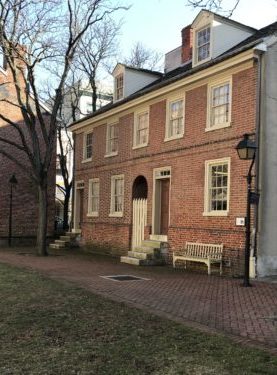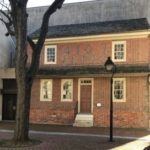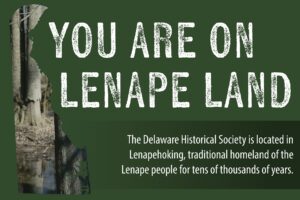Willingtown Square
Visit Willingtown Square
Willingtown Square is a charming collection of four historic buildings dating from 1748 to 1801.
Owned and maintained by the Delaware Historical Society, they were moved to their present location in 1976 from various sites in Wilmington to save them from demolition. Visit today!
What to Know About Visiting Willingtown Square
Willingtown Square is directly across the street from the museum and open to the public daily. The buildings that make up the square can be viewed from the outside but are not open to the public.
Monday – Friday
12 p.m.–5 p.m.
During warm months, the square is the perfect spot to take a peaceful lunch break, or to catch a free concert. To learn more about Willingtown Square and its buildings, visit Our Historic Properties.
Check our calendar for upcoming events!
The Buildings of Willingtown Square

William Cook built this house at 101 East Fourth Street in what was then the heart of downtown Wilmington. Dr. John Simms who called himself “a botanic electric physician,” bought the house in 1840 to serve as his shop and residence. He was later joined in the business by his son, John Henry Simms. Best known for their treatment for lung problems, the Doctors Simms mixed their tinctures in the cellar and cooked them in kettles in the first-floor fireplace. He updated the building with large windows and an awning. The Simms operated one of only two pharmacy shops specializing in herbal medicine in Wilmington at the time.
The tradition of cooking in the building continued into the 20th Before it was moved from its King Street location, it served as a restaurant. Two generations of the Valko family owned and operated “The Sanitary Luncheon” from 1919 to 1969, famous as the home of the “Original Hot Texas Weiner.

The Dingee brothers built their houses side by side at 105 and 107 East 7th Street in Wilmington. Jacob built his house in 1771, his brother Obadiah built the connecting house 2 years later.
Jacob’s house (on the left) differs from Obdiah’s in the use of glazed headers (the smaller shiny bricks) on the façade and floor plan.
Both brothers were carpenters and joiners and may have used the first floor as a workshop with their living quarters upstairs.
A bricklayer and ironmonger, then a contractor and builder occupied these houses after the Dingees continuing its occupation by those engaged in the building trades.

This house, said to be the oldest in Wilmington, originally stood at 414 West Second Street, Willington. It was built for Job and Mary Jacobs in 1748 by Griffith Minshall. Mr. Minshall included the Jacob’s initials and the date of construction in the front wall of the house. The letters and dates are arranged in the form of a puzzle.
The decorative brickwork shows the date the house was built and the initials of the owners. The date is read in a backwards “X” pattern: I, 7,4,8. The letters “I”, “M”, and “I’ in the inner part of the design stand for Job and Mary Jacobs. In the 1700, “I” and “J” were not considered to be separate letters. The diamond stood for the “&” used today.


These side-by-side houses were originally located at 107-109 East Sixth Street in Wilmington on land granted to the family by the Duke of York. Thomas Coxe, the owner of a large brick yard, built them for his two daughters Margaret and Catherine in 1801. The Coxe family occupied these houses until 1957.
In 2021, through a partnership with the Delaware Historical Society and the Jewish Federation of Delaware, the building was restored to become the home of the archives and offices of the Delaware Center for Jewish History.




